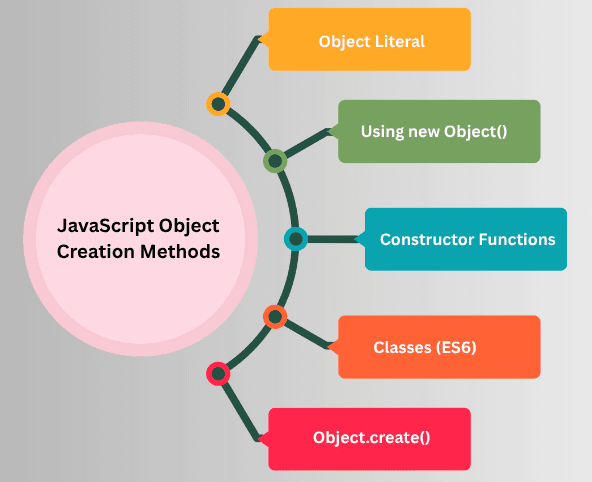Creating Objects in JavaScript
JavaScript provides multiple ways to create objects, each suited for different scenarios. Choosing the right method depends on your needs, such as simplicity, reusability, or inheritance.

1. Object Literal
The simplest and most common way to create an object, using curly braces {} to define key-value pairs directly.
- Easy to write and read.
- Ideal for creating single-use objects.
- Supports nested objects and methods.
const person = {
name: "Alice",
age: 25,
greet: function() {
console.log(`Hello, my name is ${this.name}`);
}
};
console.log(person.name); // "Alice"
person.greet(); // "Hello, my name is Alice"
2. Using new Object()
Objects can also be created using the built-in Object constructor:
- Less common than object literals.
- Useful when creating objects dynamically.
const person = new Object();
person.name = "Bob";
person.age = 30;
person.greet = function() {
console.log(`Hello, my name is ${this.name}`);
};
person.greet(); // "Hello, my name is Bob"
3. Constructor Functions
A constructor function is a custom function designed to create multiple similar objects:
- Use
thisto define properties and methods. - Instantiated with the
newkeyword. - Useful for creating many similar objects.
function Person(name, age) {
this.name = name;
this.age = age;
this.greet = function() {
console.log(`Hello, my name is ${this.name}`);
};
}
const person1 = new Person("Charlie", 28);
const person2 = new Person("Diana", 32);
person1.greet(); // "Hello, my name is Charlie"
person2.greet(); // "Hello, my name is Diana"
4. Classes (ES6)
A modern, syntactic sugar over constructor functions, introduced in ES6 (2015), for creating objects with a cleaner syntax.
- Syntax is more readable than constructor functions.
- Supports inheritance with
extendsandsuper. - Encourages object-oriented programming.
class Person {
constructor(name, age) {
this.name = name;
this.age = age;
}
greet() {
console.log(`Hello, my name is ${this.name}`);
}
}
const person1 = new Person("Eva", 26);
person1.greet(); // "Hello, my name is Eva"
5. Object.create()
Creates an object with a specified prototype, allowing custom inheritance from another object.
- Directly sets the prototype of the new object.
- Useful for prototype-based inheritance.
- Does not require a constructor function or class.
const personProto = {
greet: function() {
console.log(`Hello, my name is ${this.name}`);
}
};
const person = Object.create(personProto);
person.name = "Frank";
person.greet(); // "Hello, my name is Frank"
Comparison Table of Object Creation Methods
| Method | Syntax Example | Key Use Case |
|---|---|---|
| Object Literal | const obj = {} | Simple objects, single-use |
new Object() | const obj = new Object() | Dynamic object creation |
| Constructor Function | function Person(){} | Multiple similar objects |
| ES6 Class | class Person {} | Object-oriented, reusable, clean syntax |
Object.create() | Object.create(proto) | Prototype-based inheritance |

